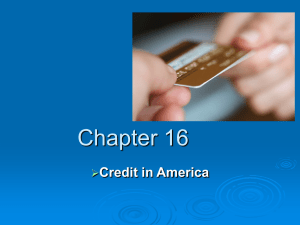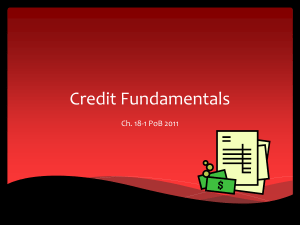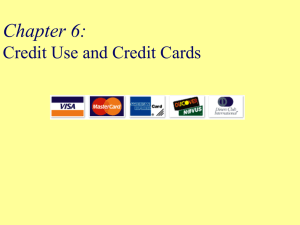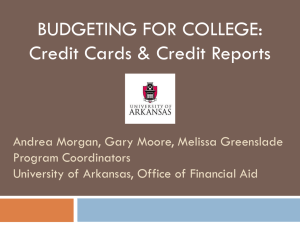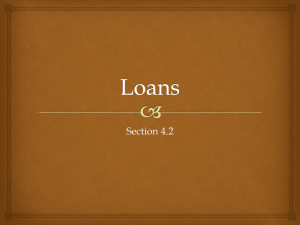Chapter 5a: Consumer Credit Part I
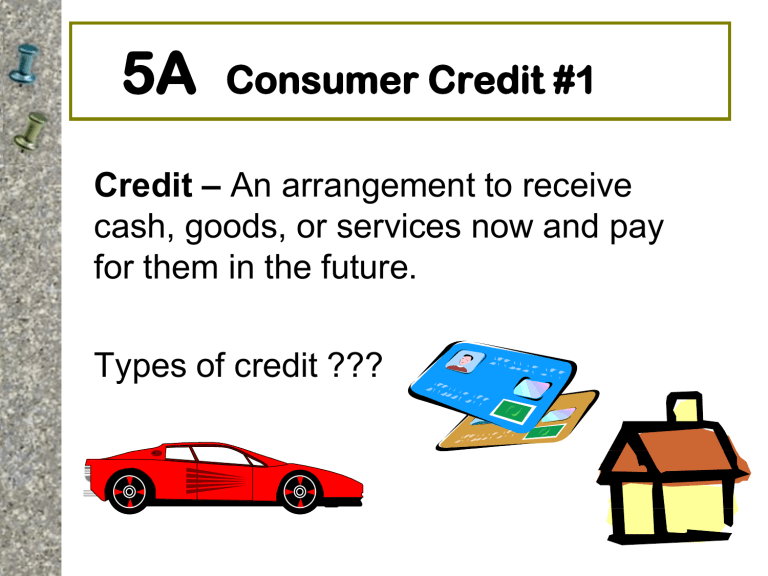
5A
Consumer Credit #1
Credit – An arrangement to receive cash, goods, or services now and pay for them in the future.
Types of credit ???
Objective 1
Analyze Advantages and Disadvantages of Using Consumer Credit
• Credit
– Based on trust in people’s ability and willingness to pay bills when due
• Consumer Credit
– Use of credit by individuals for personal needs, except a home mortgage
– Dates back to colonial times; exploded after invention of cars
(installment loans; traveling)
– A major force in our economy
5-2
Uses and Misuses of Credit
Before you use credit for a major purchase, ask:
– Do I have the cash for the down payment?
– Do I want to use my savings for this purchase?
– Does the purchase fit my budget?
– Could I use the credit I’ll need in some better way?
– Can I postpone this purchase?
– What are the opportunity costs of postponing this purchase?
– What are the dollar and psychological costs of using credit for this purchase?
5-3
Advantages of Credit
• Current use of goods and services
• Permits purchase even when funds are low
• A cushion for financial emergencies
• Advance notice of sales
• Easier to return merchandise
• Convenient when shopping
• Provides a record of expenses
5-4
More Advantages of Credit
• One monthly payment
• Safer than carrying cash
• Needed for hotel reservations, car rentals, and shopping online
• Take advantage of “float” time/grace period
• Rebates, airline miles, cash-back rewards, or other “perks”
• Credit indicates financial stability
5-5
Disadvantages of Consumer Credit
• Temptation to overspend
• Can create long-term financial problems and slow progress toward financial goals
• Potential loss of merchandise due to late or non-payment
• Ties up future income
• Credit costs money - more costly than paying with cash
5-6
Objective 2
Assess the Types & Sources of
Consumer Credit
Two Basic Types of Consumer Credit
• Closed-End Credit
– One-time loans for a specific purpose paid back in a specified period of time
• Open-End Credit
– Use as needed until line of credit max reached
Examples of each?
5-7
Closed-End Credit
• One-time loans for a specific purpose that you pay back in a specified period of time, and in payments of equal amounts
• Mortgage, automobile, and installment loans for furniture, appliances and electronics
• 3 most common types of closed-end credit
1. Installment sales creditloan for high-priced items
2. Installment cash creditloan of cash for personal use
3. Single-lump creditloan repaid on a specific day
5-8
Open-End Credit
• Use as needed until line of credit max reached
– Credit cards
– Department store cards
– Home equity loans
• You pay interest and finance charges if you do not pay the bill in full when due
• Revolving Check Credit (Bank Line of Credit)pre-arranged loan for a specified amount; can be accessed with special checks
5-9
Sources of Consumer Credit
Loans
– Borrowing money with an agreement to repay, along with interest, within a certain amount of time (e.g., 3 years)
• Inexpensive loans
– Parents or family members
• Medium-priced loans
– Commercial banks, savings and loan associations, and credit unions
• Expensive loans
– Finance and check cashing companies
– Retailers (e.g., department store credit cards)
– Bank credit cards and cash advances
5-10
Sources of Consumer Credit
• Home Equity Loans
– Loan based on home equity
• Current market value of your home minus the amount you still owe on the mortgage
– Interest is tax-deductible
– Should only be used for major purchases
• Credit Cards
– Average cardholder has > 9 credit cards
– Convenience users vs. borrowers
– Finance charge = total amount paid to use credit
5-11
Sources of Consumer Credit
• Debit Cards
– Debit cards electronically subtract money from savings or checking accounts
– Most commonly used at ATMs
– Widely accepted at stores also
• Stored Value Cards
– Gift cards
– Prepaid cards
5-12
Sources of Consumer Credit
• Smart Cards
– Plastic card equipped with a computer chip that can store
500 times as much data as a normal credit card (e.g., health info)
• Travel and Entertainment (T&E) cards
– Not really “credit cards”; balance is due in full each month
– Diners Club; American Express
– You don’t pay for goods or services at the time of purchase
5-13
Objective 3
Determine Whether You Can Afford a
Loan and How to Apply for Credit
Before you take out a loan, ask yourself...
Can you meet all your essential expenses and still afford the monthly loan payments?
– Add up basic monthly expenses and subtract from take-home pay; will the difference cover the monthly payment? (NO? Can’t afford it!)
– What do you plan to give up in order to make the payment?
5-14
General Rules of Credit Capacity
Debt Payments-to-Income Ratio
Monthly Debt Payments*
Net Monthly Income
Consumer credit payments should not exceed a maximum of 20% of your net income .
* Not including a house payment, which is a long-term liability
5-15
General Rules of Credit Capacity
Debt To Equity Ratio
Total Liabilities
Net Worth*
=
Should be < 1
*Excluding home value
The lower the ratio, the better; e.g., 0.5 or 0.25
5-16
The Five C’s of Credit
• Character - Do you pay bills on time?
• Capacity - Can you repay the loan?
• Capital - What are your assets and net worth?
• Collateral - What assets do you have to secure the loan?
• ConditionsLenders will review how general economic conditions will affect your ability to repay your loan
5-17
FICO & VantageScore
• FICO Credit Score
– 300 to 850 range
– Higher score = less risk
– Available from http://www.myfico.com
for a fee; can sometimes get for free from lenders
• VantageScore
– New scoring technique
– Developed collaboratively by 3 credit agencies
– Range = 501 to 990
5-18
Credit Scoring Factors
• Bill payment history, weighted to emphasize past 12 months (35%)
• Proportion of outstanding debt to available credit limits (30%)
• Length of credit history (15%)
• Number of recent credit inquiries (10%)
• Mix of types of credit used (10%)
Factors of Creditworthiness
ECOA (Equal Credit Opportunity Act)
– Gives all applicants the same rights.
– Credit providers may not discriminate based on:
• Age
• Social Security or public assistance
• Housing loans (redlining)
– If you are denied credit, you have the right to know the reasons
• You can request a copy of your credit report within 60 days if you are denied credit based on what is in your files
5-20
Your Credit Report
• Credit Reports
– Record of your complete credit history
• Credit Bureaus
– Agencies that collect information on how promptly people and businesses pay their bills
– Experian , Trans Union and Equifax are the 3 major credit bureaus
– Credit Bureaus obtain information from banks, finance companies stores, credit card companies and other lenders
5-21
Four Main Parts to a Credit Report
• Identifying Information: name, SS Number, current/previous addresses, birthdate, employer
• Public Record Information from Local
Courthouse: liens, foreclosures, bankruptcy
• Other Credit History Information: list of loans and credit cards, timeliness of payments, defaults and negative information (7 years)
• Inquiries: Usually 2 years; self-initiated and promotional (for marketing purposes)
Your Credit Report
• Who can obtain a credit report?
– Only authorized persons have access to your report for approved legitimate business purposes
– Examples???
• Time Limits on Unfavorable Data
– Adverse data can be reported for 7 years
– Bankruptcy can be reported for 10 years
5-23
Wrap Up
• Concept Check 5-1- Reasons to Borrow and Advantages/Disadvantages
• Concept Check 5-2- Definition of Terms;
Difference Between Credit and Debit
Cards
• Concept Check 5-3- Definition of Terms




